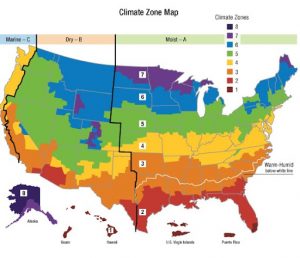I’m often asked by my solar customers if their solar system will generate enough electricity for them to convert from a fossil-fuel-based heating system to an electricity-based heating system. As it turns out, this is not a difficult question to answer. It does however, require some knowledge about how much fossil fuel you use for heating, several conversion factors, and a bit of math. Here’s a worked example.
My customer provided me with his heating oil usage and the specifications on a whole-house air-source heat pump he was considering purchasing.
His oil usage was 750 gallons per year (about three tank fill-ups for him). The heat pump had a HSPF (Heating Seasonal Performance Factor) of 10.5. So, how much electricity will he use if he “fires” his oil boiler and “hires” a heat pump?
First, we need to assume that my customer won’t change his heating patterns. In other words, he won’t run the house hotter or colder than he did with his oil system. Good assumption? Who knows? But we must make it for the sake of the math below.
To start, let’s determine how many kilowatt-hours (kWh) of oil he is using per year. Kilowatt-hours of oil? Yes, kWh of oil. It may seem odd that I’m referring to oil in electrical energy units. But the cool thing (pun not intended) about energy units like kWh is that they are easily determined with some basic conversion factors. In fact, BTUs (British Thermal Units), Kilowatt-Hours, and Therms are all units of energy. And if you know the volume of the fossil fuel, and the energy generated by burning a unit of the fossil fuel, you can quickly (with a couple of google searches) figure out the conversion factors.
My customer uses 750 gallons of oil per year. If you Google “BTUs per Gallon of Oil” you’ll get 138,500 BTU/Gallon. Using this conversion, you calculate 750 x 138,500 and come up with the total BTUs. That’s my customer’s heating load. However, we are not done yet. Unfortunately, no furnace or boiler is 100% efficient. (2nd law of thermodynamics – it’s not just a good idea, it’s the law. 😊 ) The typical oil boiler is about 80% efficient. That means that of the 138,500 BTUs of energy obtained from burning a gallon of oil, only 110,800 are usable. The rest goes up the chimney. ☹
750 gallons x 110,800 BTUs per gallon yields 83,100,000 BTUs (often expressed as 83.1MBTU). And to convert the BTUs to kilowatt-hours, Google “BTUs to kWH conversion” and you’ll get 3,412 BTUs per kilowatt-hour. So when we divide 83,100,000 by 3,412 we get 24,355 kilowatt-hours. Thus 750 gallons of oil is equivalent to 24,355 kilowatt-hours of energy. But wait, there’s more.
Heat pumps are magic. (well, actually it’s physics but you know what Arthur C. Clarke, the famous writer wrote right? “Any sufficiently advanced technology is indistinguishable from magic.”).
Why are heat pumps magic? Because you can put one kilowatt-hour of energy into one and it will move more than one kilowatt-hour of energy from one space to another. The input energy (electricity) runs a compressor, controls electronics, and fans to take advantage of the physics of compressing and expanding a gas to move heat from one space to another. In the case of a refrigerator (yes, your refrigerator is a heat pump), it moves heat out of the fridge and into your kitchen. In the case of minisplit, in the winter it moves heat from the outdoors into your home (or the other way in the summer). This “multiplication” of input energy is described as the heat pump’s Coefficient of Performance (COP).
While the COP is not usually published, you can determine it from the published “Heating Seasonal Performance Factor (HSPF). The math is simple. Multiply the HSPF by 0.293 to convert to COP. Thus, a heat pump with a Heating Seasonal Performance factor of 10.5 has a COP of 3.1. Keep in mind that the HSPF is determined as if the heat pump was installed in the warmer Climate Zone 4 environment. Here in New England, we live in Climate Zone 5. Thus, the HSPF for (most of) Maryland (CZ4) is higher than Massachusetts (CZ5). 
Oh, and another “cool” fact – Most heat pumps are reversible. They can be used for cooling too. And the cooling COP is usually much higher than the Heating COP because in the warm weather there is a lot more heat to move than in the cold weather so it’s easier to do.
Ok, back to the math. If you recall, we were going to replace 750 gallons of oil with a heat pump and electricity. And the last value we figured out was that 750 gallons of oil was equivalent to 24,355 kilowatt-hours of energy – in this case, electricity. The last step is to factor in the “efficiency” of our new heating plant. That’s where the COP comes in. Recall that the COP tells us how much energy we can move per unit of energy expended. We computed the COP for a typical heat pump in heating mode at 3.1.
Thus, to replace our 750 gallons of oil using a HSPF 10.5 heat pump, we would need 24,355/3.1 = 7,856 kilowatt-hours.
One other thing, older homes are not as “tight” as new homes. Thus, even though my customer will “fire” his oil boiler, he will keep the oil boiler on retainer for those really really cold days, just in case the heat pump can’t keep up.
All the usual caveats apply, “your mileage may vary,” COP is based on zone 4 climate, New England is in the colder zone 5. Your current gas/oil heating plant efficiency is probably NOT what it was when it was new (it’s probably worse), you don’t change behavior when you get your new heating plant, etc. etc. etc.
And remember, this is a model. The mathematician George Box said it best, “All models are lies, some models are useful.”
I hope you found this useful.




